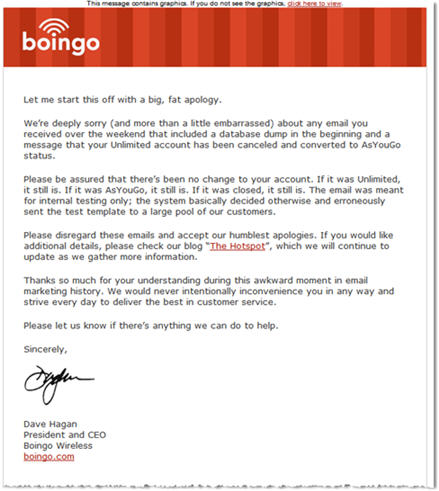If you’ve been involved in email marketing for any length of time, no matter how diligent and prepared you are for every campaign, something somewhere at some point will go wrong. And when that happens, a very large number of people will receive a message from you that isn’t quite what you intended for them to receive. It’s happened to all of us.
It happened to Boingo Wireless last week. Boingo is a leading global network of Wi-Fi hotspots (if you travel, you’ve likely used their service at an airport) and a few days ago they sent a very befuddling email to a significant pool of users – this blogger included – something to do with how my account was changing to a different plan. When, of course, it wasn’t.
But then a remarkable thing happened. I received another email, shown below, from no less than the President and CEO of Boingo, apologizing for the mix-up. And what a beautiful apology it is.
 If you hadn’t noticed, corporate apologies are all the rage. Scarcely a day goes by when some executive from oh, say: an auto manufacturer or mortgage company, isn’t engaged in some serious groveling. Most of that groveling comes across as remarkably insincere.
If you hadn’t noticed, corporate apologies are all the rage. Scarcely a day goes by when some executive from oh, say: an auto manufacturer or mortgage company, isn’t engaged in some serious groveling. Most of that groveling comes across as remarkably insincere.
But not this time. I’ve been trying to put my finger on why that is, and here’s what I’ve come up with:
1. It’s from the head honcho. That may seem an obvious decision to some, but most “sorry we sent you that email” emails are from some poor flunky further down the corporate totem pole. And when that happens, the implied message is: “no-one above my level is taking responsibility for this.”
2. It explains the problem (a technical glitch) and provides a convenient resource for discovering more information by directing people to the company blog. Perfect. Not only can I learn EXACTLY what happened if I want to, but I can also feel confident that the information is current.
3. I am assured that nothing is wrong with my account. Not just in a flip, off-hand, “there’s no problem” way, but definitively, as in “we really want you to understand there’s absolutely no problem whatsoever.”
4. The tone. Now this is the really artful part, but the email is actually pretty funny. Which is a risk, when you think about it (“they got me freaked out about my account, and they’re making JOKES about it?”) but here it’s very disarming, starting with the very first line:
“Let me start this off with a big, fat apology.”
and in the penultimate paragraph when the CEO makes reference to “this awkward moment in email marketing history.”
I’m sorry, but that’s brilliant.
It was pretty obvious to me, and likely to most people who received the errant emails (plural – I received 3 copies in quick succession) that this was clearly a mistake and nothing was amiss. But in this post-Toyota era, it pays for companies to come clean about their errors, and to come clean quick. And Boingo have shown how to do it right.

Great apology! They did a great job of fessing up and nipping it in the butt. Props to the marketing team on this brilliant job.